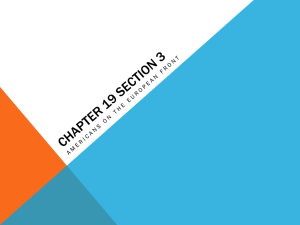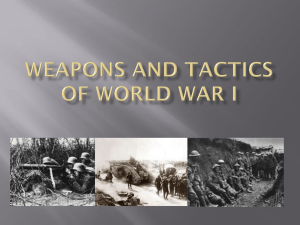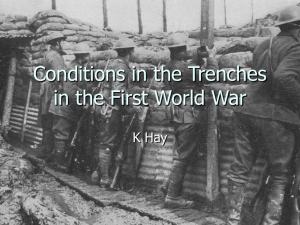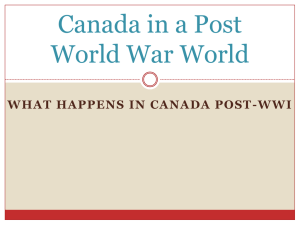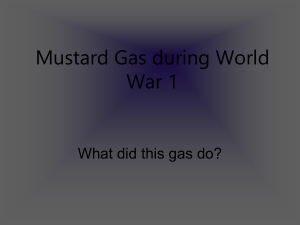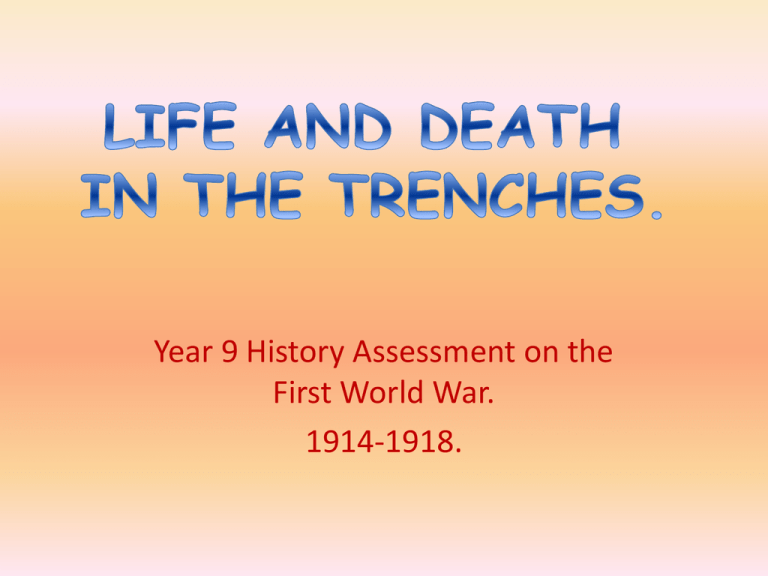
Year 9 History Assessment on the
First World War.
1914-1918.
“Living and fighting in the
trenches was a terrible and
terrifying experience for all the
soldiers involved”
What evidence is there
for and against this statement?
In this assessment you will find out about conditions in the British
trenches on the Western Front during the First World War.
You will use a range of SOURCES:
•Photographs.
•Diaries
•Memories of old soldiers.
•Film.
•Textbooks
•Songs
•Poems
•Statistics
•Websites
The resources you need can be found on
www.sirbernardlovell.s-gloucs.sch.uk
Look for the eportal >HISTORY. > Yr9.
1.
2.
Click on Trenches Assessment for the questions.
Click on Life and Death in the Trenches to find sources.
You need to use the sources not copy them.
How to annotate photographs
Barbed wire
Timber bridge over
top of trench
Soldier on sentry
duty
No Mans’ Land
Helmet, uniform and
rifle are British
Timber holding up
back of trench.
Capes
used as
cover
No sandbags.
Trench may be
damaged
Bottom of trench
is dry. It could be
summer.
This photograph does not looked posed
as the soldier seems unaware of the
camera. It is probably a reliable source.
Water cans.
Are these
soldiers asleep or
dead?
Source A.
Wounded British soldiers waiting to be taken to a field hospital behind the
front line.
Source B.
British soldiers playing football at a camp behind the front line.
Source C. Diary
EXTRACT FROM THE DIARY OF JULIAN GRENFELL
A young poet, killed on 26 May 1915
"I adore war. It's like a big picnic . . . I've never been so
well or happy. No one grumbles at one for being dirty. I
have only had my boots off once in the last ten days and
only washed twice.“
What does Source C tell us about life in the trenches?
How reliable are diaries written by soldiers in the trenches?
Source D. Letter.
Captain Lionel Crouch wrote to his wife about life in the trenches in
1917.
Last night we had the worst time we've had since we've been out. A
terrific thunderstorm broke out. Rain poured in torrents, and the
trenches were rivers, up to one's knees in places and higher if one fell
into a sump. One chap fell in one above his waist! It was pitch dark and
all was murky in the extreme. Bits of the trench fell in. The rifles all got
choked with mud, through men falling down.
Why is source D (letter) so different from Source C (diary)?
How reliable are letters from soldiers about life in the trenches?
Source E. Casualties in the First World War.
How bad were British casualties compared with other countries?
Killed
& Died
Wounded
Total
Casualties
Casualties %
of Mobilized
Allied Powers
Russia
12,000,000
France
8,410,000
1,700,000
1,357,800
4,950,000
4,266,000
9,150,000
6,160,800
76
76
British Empire 8,904,467
908,371
2,090,212
3,190,235
35
Italy
5,615,000
650,000
947,000
2,197,000
39
United States 4,355,000
126,000
234,300
364,800
8
Total
Central
Powers
Germany
AustriaHungary
Turkey
Total
Grand Total
42,188,810
5,152,115
12,831,004
22,104,209
52
11,000,000
1,773,700
4,216,058
7,142,558
64
7,800,000
1,200,000
3,620,000
7,020,000
90
2,850,000
22,850,000
65,038,810
325,000
3,386,200
8,538,315
400,000
8,388,448
21,219,452
975,000
15,404,477
37,508,686
34
67
57
Countries
Total
Mobilized
Source F. Silent Film. The Battle of the Somme.
This film was made before and during the Battle of the Somme by
filmmakers working for the British Army. It was the world’s first fulllength war documentary. It was shown in British cinemas in August
1916. Over the next three months almost half Britain’s population had
gone to see it.
The film is a silent film (talkies do not arrive until 1929). When it was
shown it would have been accompanied by a live piano or organ. Title
frames provided information.
What could the film tell us about life in the trenches?
What could the film not show?
Battle of the Somme.
Film.
http://www.youtube.com/watch?v=EpRc6lx_7wg&feature=related
Part of the original 1916 film
Source G. BBC Documentary. 2002. The Trench.
Why was it produced?
A docudrama to show people how living and fighting in the trenches affected the
soldiers. A reconstruction of events in October 1916 taken from the War Diary of the
East Yorkshire Regiment (the Hull Pals).
What does it tell us?
Trench routines e.g. duties, sleeping, eating, shaving, washing, foot inspections,
keeping warm.
Soldiers only spent 5-10 days in direct contact with the enemy. Rotated every few days.
Bombardments. Gas attacks. Raids. Standing to. Friendships. Leisure? Roll calls.
When and where did they sleep?
How important were letters?
What did they eat and drink? The average British soldier gained a stone and a half in
the army.
Sentry duties: 1 in 3 soldiers at night. 1 in 10 soldiers in the day time.
What did soldiers miss most?
How reliable is it?
A lot of research was done to make sure it was as authentic as possible. However the
“soldiers” knew that they were only acting.
• Source H. BBC website. How did so many
soldiers survive the trenches?
• http://www.bbc.co.uk/guides/z3kgjxs
• Source I. BBC website on World War One.
• http://www.bbc.co.uk/ww1
“Living and fighting in the trenches was a terrible and
terrifying experience for all the soldiers involved”
What evidence is there for and against this statement?
Your answer should be in four parts.
1. Introduction. Explain the question.
2. Evidence that the soldiers’ experience
was terrible and terrifying.
Photographs.
Diaries
Memories of old soldiers.
Films.
Casualty figures.
How were soldiers killed or wounded?
What were the trenches like?
Health and hygiene problems.
Shell shock.
Desertion.
Examples of battles such as the Somme
(1916) and Passchendaele (1917)
3. Evidence that the soldiers’ experience
was not always so bad.
Photographs.
Diaries
Memories of old soldiers.
Films.
Casualty figures.
Why did some soldiers enjoy life in the
army?
How much contact did soldiers have with
the enemy?
Why were soldiers not always in the
front line?
Which army roles kept soldiers away
from the front line?
Why did some soldiers cope better with
the traumas of war?
4. Conclusion.
Give a balanced conclusion. Did some soldiers have a terrible
experience?
Did some soldiers have a better experience?
Clues
Evidence that the soldiers’ experience
was terrible and terrifying.
Evidence that the soldiers’ experience
was not always so bad.



